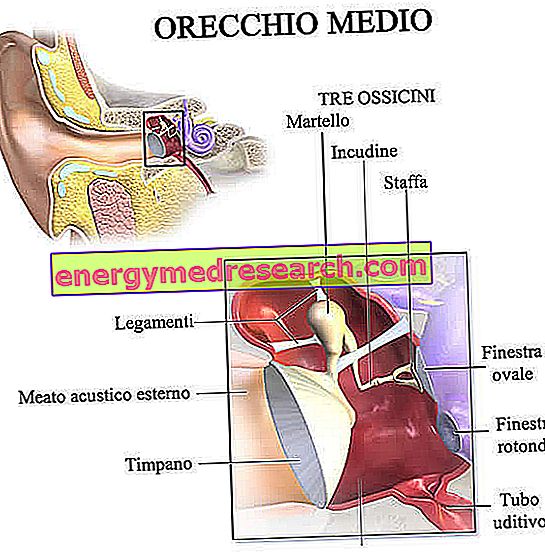TRIATEC ® is a drug based on ramipril
THERAPEUTIC GROUP: Antihypertensives - ACE inhibitors not associated.
IndicationsAction mechanismStudies and clinical effectiveness Usage and dosage instructionsWarnings Pregnancy and lactationInteractionsContraindicationsUndesirable effects

Indications TRIATEC ® Ramipril
TRIATEC ® is used - both alone and together with other antihypertensive drugs - in the treatment of high blood pressure. TRIATEC ® in addition to cardiac diuretics and glycosides, is also indicated in the treatment of congestive heart failure, and in monotherapy in slowing the progression of renal failure or in the case of established renal diseases in non-diabetic patients.
Mechanism of action TRIATEC ® Ramipril
Ramipril, the active ingredient of TRIATEC ® is rapidly absorbed following oral administration, so that the blood peak is reached after about an hour. However, ramipril is only an inactive precursor of the molecule with therapeutic activity. This substance, called ramiprilat, is synthesized in the liver following hydrolysis of its precursor (ramipril).
The maximum peak of the active form is observed about 2/4 hours after oral administration, with a bioavailability of about 20% of the starting dose.
Ramiprilat - both at systemic and tissue level - inhibits the enzyme dipeptidylcarbepteptidase I, and prevents the conversion of angiotensin I into its active metabolite, angiotensin II, with the simultaneous increase in bradykinin values. The reduction in angiotensin II levels leads to a significant decrease in the concentration of aldosterone, the vasoconstriction process and the hydro-saline retention. The increased production of bradykinin allows instead to mediate a sensitive vasodilatory action. The biological union between these two actions takes the form of a reduction in arteriolar vascular resistance, therefore in a significant drop in blood pressure that starts around the third fourth hour, is optimized around the third fourth week of treatment and lasts up to 2 years, without any effect rebound or adaptive (increased heart rate or rebound hypertension).
The antihypertensive action on the one hand, and the increase in bradykinin levels on the other, could be responsible for the jar and cardioprotective action exerted by ramiprilat.
Once its action is over, the ramiprilat is removed mainly by renal pathways, with different timing due to a variable half-life, between 3 hours and 4/5 days.
Studies carried out and clinical efficacy
1 RAMIPRIL IN THE HYPERTENSION
Treatment with 5 mg daily of ramipril for 4 weeks, in patients with arterial hypertension, showed a drop in systolic pressure of about 15mmHg, without obvious side effects except for dry cough.
2. THE EFFECTS OF RAMIPRIL IN WOMEN AFTER PROLONGED TREATMENT
2480 women, suffering from vascular diseases or type II diabetes and treated with ramipril at doses of 10mg / day for prolonged periods of time, were monitored for the incidence of cardiovascular events. The careful critical evaluation has shown how the presence of cardiovascular accidents has been avoided in the treated group and the systolic function has been preserved.
3. RAMIPRIL AND RISK OF DIABETES
Experimental models are clarifying the biological role of ramipril in the protection from diabetic pathology, probably involved in the reduction of insulin resistance. This 2001 precursor study laid the foundations for experimentation, observing how in 5720 patients with vascular pathologies, diabetes familiarity and overweight, therapy with 10 mg daily ramipril significantly reduced the incidence of diabetic pathology in high-risk individuals. However, it is necessary to clarify that in the literature there are no other studies that contradict these results.
Method of use and dosage
TRIATEC ® Tablets 1.25, 2.5, 5 and 10 mg of Ramipril: for the treatment of hypertension, the most effective and most commonly used dose appears to be 2.5 milligrams per day, although at generally bi-weekly intervals it can be increased up to a dose daily maximum of 10mg.
In these latter cases, and in case of resistance to monotherapy, it is preferable to combine TRIATEC ® with another antihypertensive drug. In the treatment of congestive heart failure, the initial dose is 1.25 mg per day, to grow up to 5/10 mg as long as administered in different intakes.
In the treatment of overt nephropathy of non-diabetic origin, the suggested dosage is 1.25 mg per day, possibly to be increased with twice weekly frequency up to a maximum of 5 mg daily.
All the appropriate corrections and any different treatment plans should be evaluated exclusively by the doctor, after a careful evaluation of the patient's physio-pathological conditions, the objectives and the severity of the disease, taking into account that for particular risk categories it would be advisable not to exceed the maximum daily dose of 2.5 mg.
The intake can occur either before, during or after meals, as food intake does not seem to interfere with the pharmacokinetics of the active ingredient.
Warnings TRIATEC ® Ramipril
When the use of ACE inhibitors such as rimapril is accompanied by facial, head and neck angioedema, administration of this drug should be stopped immediately.
In addition, continuous medical monitoring and monitoring of blood pressure and electrolyte would be necessary in patients suffering from heart failure, from relevant hemodynamic alterations, from previous therapy with diuretics, undergoing therapy with ACE inhibitors or affected by gastrointestinal tract disorders that facilitate the loss of liquids, such as diarrhea and vomiting.
Furthermore, given the excretion of ramiprilat mainly by the kidneys, alterations in renal function or anuria, could delay the elimination of the drug and enhance the biological effects of the active ingredient.
A dosage adjustment may be necessary in case of concomitant administration of antihypertensive drugs or in patients with renal insufficiency or liver disease.
The administration of antihypertensive drugs generally exposes the patient to potential hypotensive episodes, dizziness and drowsiness, which could compromise the normal perceptive and reactive capacities, making the use of vehicles or machinery particularly dangerous.
IN ANY CASE, BEFORE TAKING TRIATEC ® Ramipril - THE REQUIREMENT AND CHECK OF YOUR DOCTOR IS NECESSARY.
PREGNANCY AND BREASTFEEDING
It would be necessary to avoid taking TRIATEC ® during the entire pregnancy, in order to avoid even irreversible damage to the fetus. In case of real need, it is good to prefer other antihypertensive drugs with reduced risk profile for the health of the fetus.
Ramipril is excreted in small part in breast milk; therefore it would be necessary to suspend breastfeeding if TRIATEC ® is taken
Interactions
There are different pharmacological and non-drug interactions described for TRIATEC ®
- Interactions with negatively charged membranes, such as those from hemodialysis, could lead to an increase in anaphylactic episodes;
- Concurrent administration of potassium supplements or potassium-sparing diuretics could lead to an increase in kaliemia;
- The simultaneous intake of hypoglycemic drugs could lead to a significant glycemic decrease, given the increased sensitivity to insulin induced by ramipril;
- Non-steroidal corticosteroids and anti-inflammatory drugs could determine an increase in hydro-saline retention with reduction of the hypotensive effect;
- Lithium salts may accumulate and increase the cytotoxic effect.
Contraindications TRIATEC ® Ramipril
The use of TRIATEC ® is not recommended in case of innate hypersensitivity - or induced by hemodialysis filters - towards one of its components, in the case of angioedema, clinically significant renal disorders with hemodynamic alterations, and hypotension.
Undesirable effects - Side effects
Most of the side effects associated with taking TRIATEC ® are related to the hypotensive effect of rimapril. More precisely, hypovolemic episodes can be quite frequent, especially in the initial phases of treatment, changes in sleep, dizziness, sweating, dry cough, palpitations, fatigue, nausea and diarrhea.
Rarer and generally associated with the concomitant administration of diuretics, there are instead side effects such as hyponatremia and hyperkalemia, peripheral angioedema, increased levels of creatinine and urea, and changes in blood count and plasma values of liver enzymes.
In the case of hypersensitivity, I mainly describe skin and respiratory reactions.
Note
TRIATEC ® is salable only under medical prescription.



